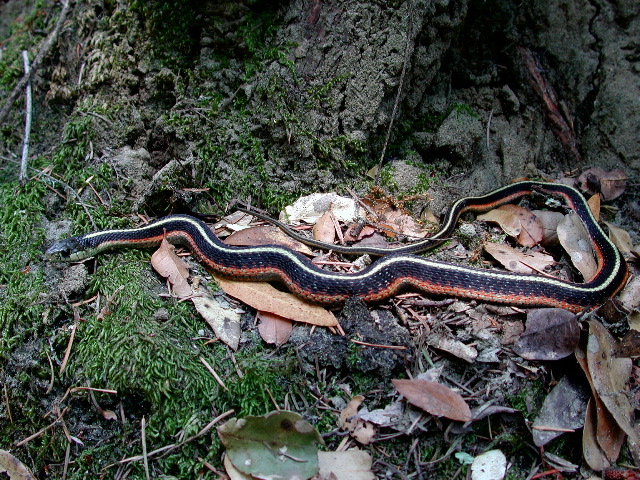It appears I’m in the mood for classics lately…or maybe it’s the researchers who are? I recently took to the blog to discuss the discovery of the jumping gene mutation responsible for turning white peppered moths black. Right on its heels has come another insight into the mutations responsible for yet another classic evolution case study.
Let’s start at the beginning, which in this case involves a legend worthy of a B movie: three hunters go into the woods in the 1960s and die mysteriously while sitting around the campfire. There was no obvious cause of death evident, and the only thing that seemed out of place was a roughskin newt (genus Taricha) floating in the coffee pot. I don’t know if this legend is true, but it was enough to get an undergraduate student, Edmund Brodie, Jr., interested. (In the B movie in my head, Brodie Jr. would be played by someone like Rupert Grint with an American accent. Accio cause of death!)
In a quest for answers, Brodie collected newts and fed their skin excretions to other animals, all of which promptly died. Clearly onto something, a team of chemists followed up and determined that the newts produced the chemical tetrodotoxin (TTX). If tetrodotoxin doesn’t mean anything to you, maybe this will help: You know how incorrectly prepared pufferfish (fugu if you speak sushi) can kill you instantly? That’s because pufferfish livers and skins excrete TTX. TTX is absurdly lethal—about ten thousand times more deadly than cyanide—and these newts produce tons of it. Toxins require a big investment of energy to produce, and as a general rule, organisms don’t spend energy without reason. It’d be very strange if an animal made excess amounts of such a metabolically expensive compound. Is there some kind of super-newt-predator that can only be taken down by a TTX dose big enough to kill several people? Bigfoot, maybe??
Well, yes—but the predator hasn’t even got feet, let alone big feet; it’s a species of common garter snake (Thamnophis sirtalis). Pause for a second to humble yourself, mighty human! A single little newt is capable of taking down you and hundreds of your friends, but a common think-nothing-of-it snake can eat the same newt without even the slightest bit of indigestion. Yet more evidence that there is no such thing as a pinnacle of evolution!
An interesting point to throw in here is that not all populations of newts and snakes are the same in terms of their toxicity/resistance. Where you find mildly toxic newts you find mildly resistant snakes. But where you find super-ridiculously-toxic newts, you also found super-ridiculously-resistant snakes. So clearly, the evolution of both populations is linked—it takes two (populations) to tango. If one population ups its game over generations, so too will the other. Increased toxicity provides selection for increased resistance, which provides selection for increased toxicity, and so on. But, if there is no selection pressure for increased toxicity or resistance, it doesn’t happen. It’s a nice illustration of how local environment (remember the environment includes living things!) shapes natural selection.

But how’d this cycle get started in the first place? That’s where the new research comes in, and to understand it we have to get into some details about how TTX works. If you think back to your biology classes, you might remember that embedded in the membranes that surround our cells are a variety of channels and gates that allow materials to come in and go out. One of these channels enables the transport of sodium ions. Sodium (yes, the same sodium that makes potato chips so delicious) is a crucial element in the body. Among other roles, it generates electrical impulses along our nerves. No sodium, no nerve action—which means no muscle movement, no brain activity, no nothing. TTX kills by blocking sodium channels and preventing sodium from doing its job. How do garter snakes avoid this fate? By having sodium channels with a slightly altered structure that can’t be shut off by TTX.
Now, there are nine different sodium channels throughout the snakes’ body. Research has focused on three types: Type 1.7, found in small peripheral (meaning not in the brain or along the spinal cord) nerve cells; Type 1.6, found in larger peripheral nerve cells; and Type 1.4, found in the muscles. Brodie Jr. and his son Edmund Brodie III, had already determined that some highly TTX-resistant garter snakes had an altered channel 1.4. The new research, released in June and headed up by Joel McGlothlin of Virginia Tech, (free summary piece here) concluded that all garter snakes had TTX-resistant shapes in channels 1.6 and 1.7. The research team, wanting to understand how these adaptations evolved, looked to the genes to determine when each occurred.
Their results were super cool. Part II will get into the details of the discovery and will answer the age-old question: which came first, the toxic newt or the toxin-resistant snake?
Are you a teacher and want to tell us about an amazing free resource? Do you have an idea for a Misconception Monday or other type of post? Have a fossil to share? See some good or bad examples of science communication lately? Drop me an email or shoot me a Tweet @keeps3.

